Editor’s Note: You can follow all the live results provided by The Canadian Press on our results page. First votes are expected around 10pm eastern.
Canadian voters go to the polls today if they were not one of the nearly six million who voted early. Prime Minister Justin Trudeau and his Canadian Liberal Party called this snap election to transform their minority government elected in 2019 – a parliamentary arrangement where the largest party lacks a majority of seats but governs with the confidence and agreement from smaller parties – into a majority government.
The Liberals are not likely to achieve their goal. Trudeau called the election after a year of comparatively large polling leads and faced a divided Conservative opposition. A series of Liberal missteps and a strong early campaign from Conservative leader Erin O’Toole briefly allowed the Conservatives overtake Trudeau’s Liberals, though polls quickly narrowed to near-ties. As voters head to vote, polls project that the topline result will resemble the close 2019 election, with a small margin of victory for either party. A more efficient Conservative vote distribution in this election means that the Parliament seat count is likely to narrow from 2019, with a possible Conservative victory.
A Competitive Election
When Decision Desk HQ covered Trudeau’s decision to call a snap election, we said that the Canadian Liberals’ advantages and the Canadian Conservatives’ numerous flaws meant that Trudeau was likely to win his coveted majority government. The Liberals can still win a majority, but this outcome is now improbable. We said earlier that Conservative’s could run a perfect campaign but this is not enough on its own, victory requires Liberal Party failures. This has proven true in this snap election.
The Liberals’ decision to call a snap election was a mistake. A majority of Canadians did not want an election during the pandemic. The opposition parties launched early and effective platforms while the Liberals waited, presenting the appearance of a Liberal electoral power grab that backfired. The race tightened, and Trudeau’s approval rating plummeted.
The Liberals have recovered from these initial missteps. Key voters perceived Trudeau to have performed well during Canada’s three national debates – two in French and one in English. Progressive NDP-Liberal swing voters began to recognize that the race was closer than previously expected and shifted their support to the Liberals. The election is now effectively tied.

The Big Picture
A tied race should return a Liberal lead in seats. Even if the Conservatives outperform their polling averages, the 2019 Election shows that the Liberals can lose the popular vote by one percent and win the election by 30 seats.
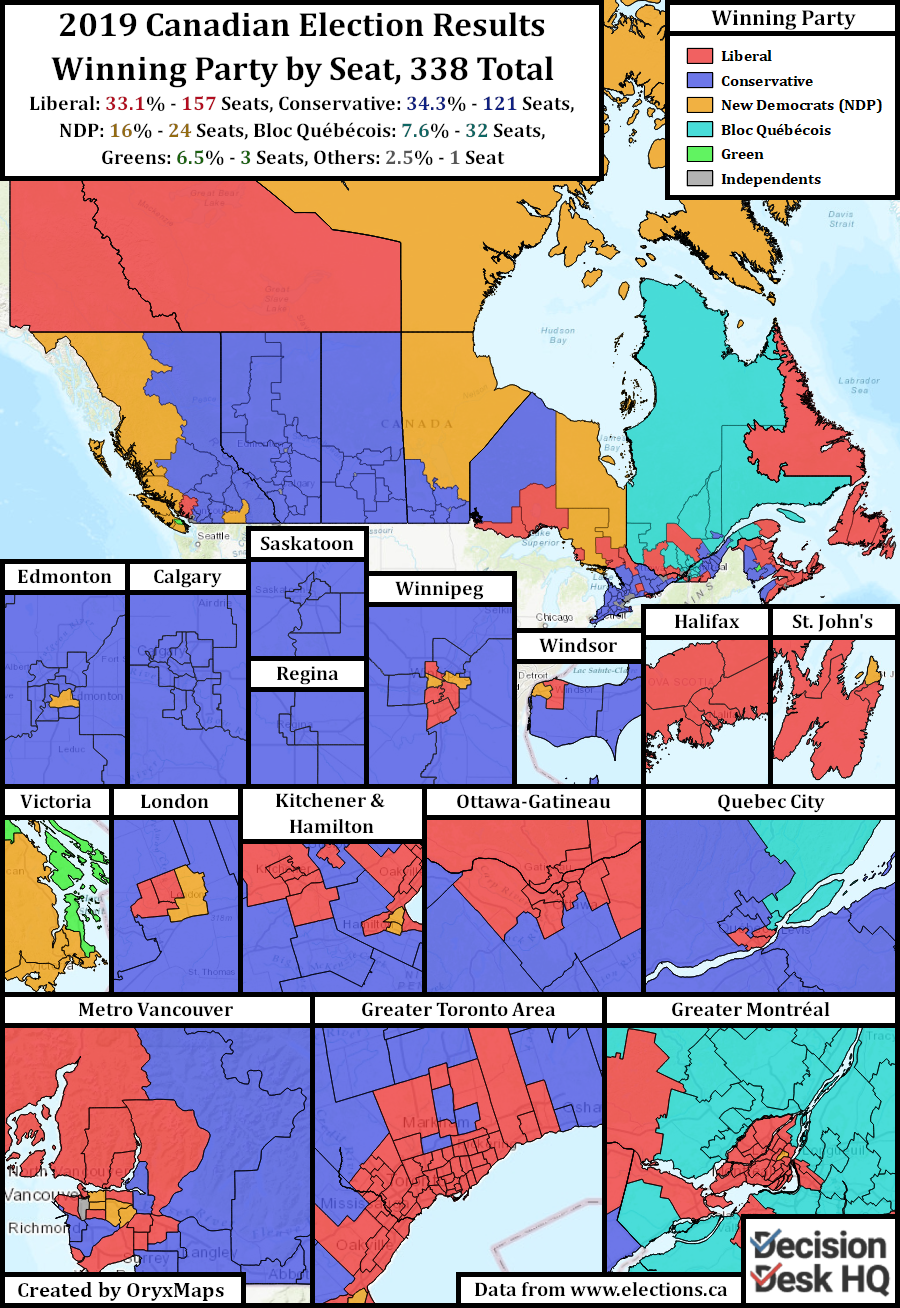
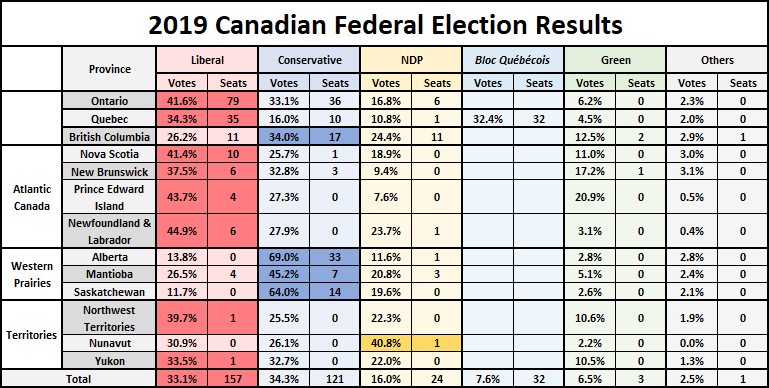
However, the Conservative vote is more efficiently distributed now than in 2019. A tied race wastes fewer Conservative votes in safe seats and gains more in marginal areas. This is because of the minor parties contesting this election – specifically the People’s Party of Canada (PPC).
The PPC is a far-right populist Party that won 1.6% of the vote in 2019. How much the PPC improves this election remains an open question – polls have no consensus when it comes to the new party. Now the PPC includes two, new constituencies: anti-vaccine agitators and disaffected westerners. The westerners gave the Conservative party it’s landslide 2019 margins in safe seats. They are now upset with the direction of Canada nationally and object to the Conservative parties present direction. If the Conservative party is tied with the Liberals nationally but has lost votes in safe, Conservative areas, then it must be gaining votes in other regions – and regional polls suggest this is occurring.
The Liberal structural advantage appears to be less powerful this election when compared to 2019 because Canada’s two sizable minor parties, the New Democratic Party (NDP) and the Bloc Québécois, are gaining votes. The NDP’s coalition is a mixture of young urban activists, union laborers, Canada’s First Nations, and British Columbia progressives. The party competes with the Liberals in urban seats and with the Conservatives in the west. The NDP appears to have surged in British Columbia from 2019 – partially fueled by the Canadian Green Party’s intramural collapse – and is polling better in urban Toronto which previously elected a full Liberal delegation.
The Bloc Québécois (Bloc for short) is a regional party for francophone Quebecers. It formerly aligned with provincial nationalists and separatists, but the disappearance of separatism as an animating issue sent the Bloc into electoral obscurity. The party re-emerged when it became the champion for the provincial CAQ, a new and popular anti-separatist Conservative party, and its premier, François Legault. The Bloc’s appeal to this brand of provincial identity and exceptionalism catapulted the party from 10 seats to 32 in 2019. Bloc leader Yves-François Blanchet emerged a winner in the 2021 debates by championing Quebec laws and customs unpopular outside the province. Now the Bloc leads or is tied with the Liberals in Quebec polling.
Governments and Vote Counts
In most circumstances, Canada does not have coalition governments. The party with the most seats forms either a majority or minority government with the tacit approval of friendly smaller parties. If it is a minority, the government might fall before its tenure ends, necessitating new elections.
This may change if the Liberals and Conservatives finish effectively tied in the seat count. A marginal lead does not confer a mandate to govern, this happened recently in the 2017 British Columbia and the 2018 New Brunswick provincial elections. Explicit support from the smaller parties – sometimes in the form of a coalition agreement – is needed in this situation to give one of the major parties a government. If the Liberals and Conservative finish within a few seats of each other, the focus changes to if the combined Liberals and NDP seat tally exceeds 170 (50.1% of the available seats), or if the Conservatives and Bloc Québécois hit 170 or more.
Provincial voting polls – the equivalent to an American voting precinct – historically report their results soon after the voting period ends. Mail ballots are counted last and this year they may take a long time to appear. Canada verifies that a mail voter did not also cast an in-person vote on election day – in which case the mail vote is tossed. For this reason all advance votes cast in person and election day votes must be counted first. The national election agency has stated that it will not begin counting mail votes until Tuesday, the day after polls close. The number of mail ballots this year and experience from recent provincial elections suggests that this process could take longer, even days, depending on the mail vote volume in any constituency. Mail voters historically favor the Liberals and the NDP by more than their national toplines.
News networks and decision desks project seats, and the overall winner, if they have enough information on election night. This official delay in vote counting may not end up consequential. However, if the result is tight, and key narrow constituencies end up deciding the overall winner, then a definitive result might not be available on election night.
Expected Electoral Variations Between the Canadian Provinces
Each major region of Canada – the Atlantic or Maritime Provinces, Quebec, Ontario, the Prairies, and British Columbia – is experiencing different political swings. The following regional breakdowns are for those who want guidance on what to track on election night. Different movements towards different parties in different provinces means that will be some churn and all major parties will flip seats.
Atlantic Provinces
Most of Canada’s polls close between 9 and 10pm Eastern, despite the county covering multiple time zones. The Atlantic Provinces however close early and will provide the first insights into the overall results.
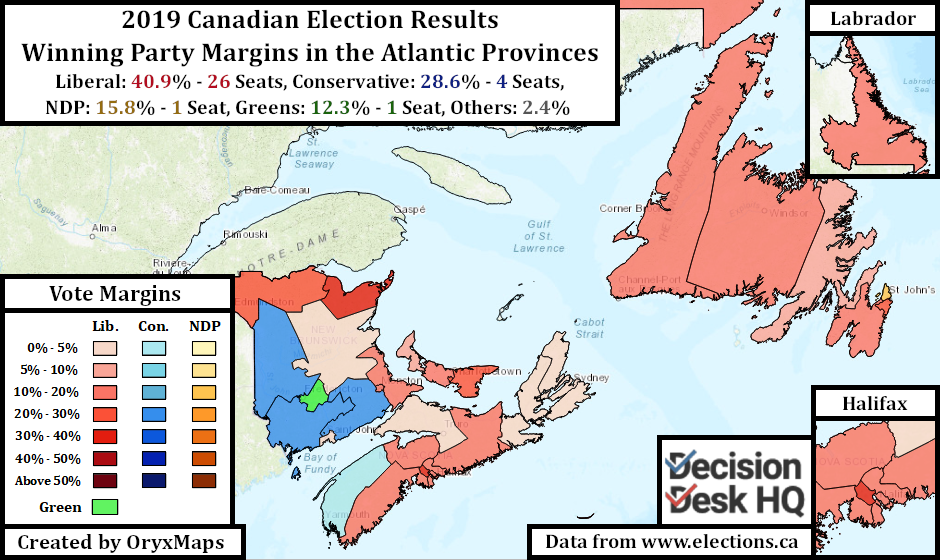
The Conservatives are likely to make gains across the four Atlantic provinces. Barring an extreme overperformance, the Liberals will retain a majority of the region’s seats, but Conservative leader O’Toole’s style of politics resonates with marginal Maritime voters. The extent of Conservative gains in the Atlantic Provinces is unclear because they have few voters compared to the overall nation and regional poll subsamples have few respondents and high margins of error.
The Conservatives have eight immediate potential gains and numerous more distant target seats to potentially flip. If, however, they lose any of the seats won in 2019 then the Conservatives will have a bad night nationally.
One of these targets is Fredericton which the Green party won in 2019. The Green Party had good regional results here in 2019, but the party has since collapsed both locally and nationally. Green MP Jenica Atwin crossed the floor and is now running for re-election as a Liberal.
The NDP are not strong in the four Atlantic provinces. The party could lose its only seat in the region – St. John’s East – because the MP retired. The NDP however is targeting other seats in Halifax for potential pickups.
Quebec
Quebec is a three-party province. The Conservatives dominate Quebec City’s environs; the Liberals dominate Montreal, Laval, and the Ottawa suburbs of Gatineau; and, the Bloc Québécois dominates the provincial periphery and the Montreal suburbs. The seats scattered between these three regions are two candidate races between the two most relevant of the three parties. The Conservatives have a much smaller base in Quebec than the other two parties and only can win 10 to 15 seats compared with 25 to 45 for the other two respective parties.
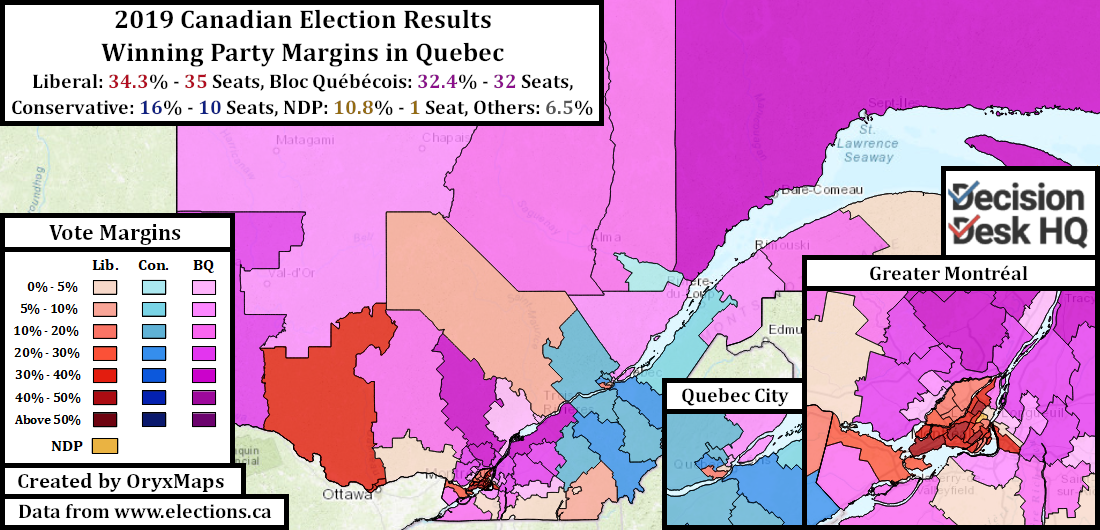
Polls show a tight race between the Liberals and the Bloc, similar to 2019, only now the Bloc has momentum. A tie benefits the Bloc, because they have the most efficient vote distribution. Montreal and Gatineau have some of the safest Liberal seats in the country, and the Liberals most loyal Quebec voters are self-packed into these constituencies. The Liberals need a solid lead provincially to overcome their geographic disadvantage. If the Liberals do end up ahead by more than five percent then they can gain large numbers of seats in Quebec.
The Conservatives are performing only slightly better than their 2019 results, despite having an endorsement from popular Quebec premier Legault, but their lack of targets means that this marginal improvement still works to the party’s advantage. The Conservatives presently prefer a strong Bloc which can win Liberal seats and support a Conservative minority government. One of the few Conservatives targets is the open seat of Trois Rivières, where they are running the former mayor of the city.
The NDP have only one seat in Quebec, but they have a handful of targets including the college city of Sherbrooke and Berthier-Maskinongé where popular former parliamentarian Ruth Ellen Brosseau hopes to reclaim her former constituency. People’s Party leader Maxime Bernier is standing against the Conservatives in his former seat of Beauce, but Quebec polls as the worst province for the PPC. A flip for the PPC appears unlikely.
Ontario
Ontario is the largest province in Canada by population because of Toronto and her suburbs. The Toronto region is only one of several sub-regions within the province, each with their own dynamics. The Toronto region itself can be subdivided between the city, the Peel cities of Brampton and Mississauga, and the other suburban regions. Toronto and other cities’ dominance over the province give the Liberals a significant geographic advantage and the majority of the party’s elected MPs.
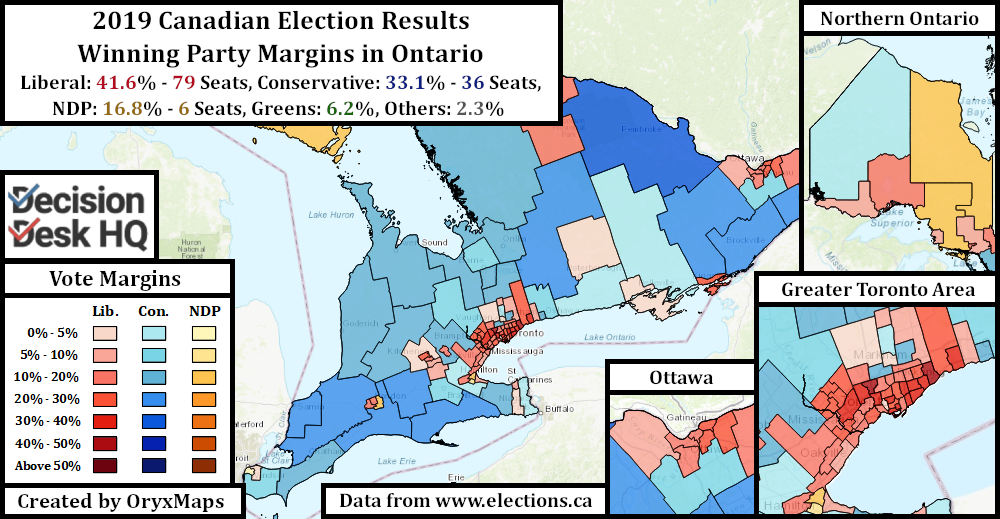
Even if the Conservatives win the most seats overall, they will lose Ontario. The Liberals lead the region’s subsample in all recent national polls and the Conservatives have a limited list of targets for a province with 121 seats. The Conservatives do not need to come on top in Ontario to win a minority government, they need to flip enough marginal seats. This is possible as a number of polls say the provincial margins have narrowed from 2019. Conservative targets can broadly be grouped into two categories: those in “rust belt” small-town regions like Niagara and Sault Ste. Marie; and wealthier suburban seats in the York or Halton regions outside Toronto. The Liberals, conversely, have targets on the few suburban seats the Conservatives won in 2019.
The NDP also hopes to gain seats in Ontario. In response to late-breaking scandals the National Liberal party unendorsed their candidates in the urban seats of Kitchener Centre and Spadina-Fort York. The main opposition in both seats is the NDP and both seats are likely pickups. However, a locally known Green candidate may disrupt NDP’s momentum in Kitchener and the Liberal disavowal in Spadina-Fort York came after several thousand voters already cast advance ballots. The remaining NDP targets can be subcategorized into either industrial constituencies – sometimes with retiring Liberal incumbents like Sudbury or Hamilton East-Stoney Creek – or downtown Toronto seats with large youth populations such as Davenport.
The Canadian Green Party’s present party leader, Annamie Paul, is running in Ontario for the seat of Toronto Centre. Paul ran here previously in a 2020 by-election and received 32.7% to the Liberals 42%. Despite spending nearly the entire campaign in Toronto Centre, the poor position of the Greens nationally make it unlikely Paul is elected to Ottawa.
The Prairies
The Conservative Party rules the three Prairie provinces. In 2019 the Conservatives won every seat in Saskatchewan, all but one seat in Alberta, and the majority of seats in Manitoba. This is the Conservative base; the party won the rural Prairies constituencies with margins over 50% – sometimes over 75%! This is how the Conservatives received their popular vote lead in 2019 without winning an equivalent number of seats.
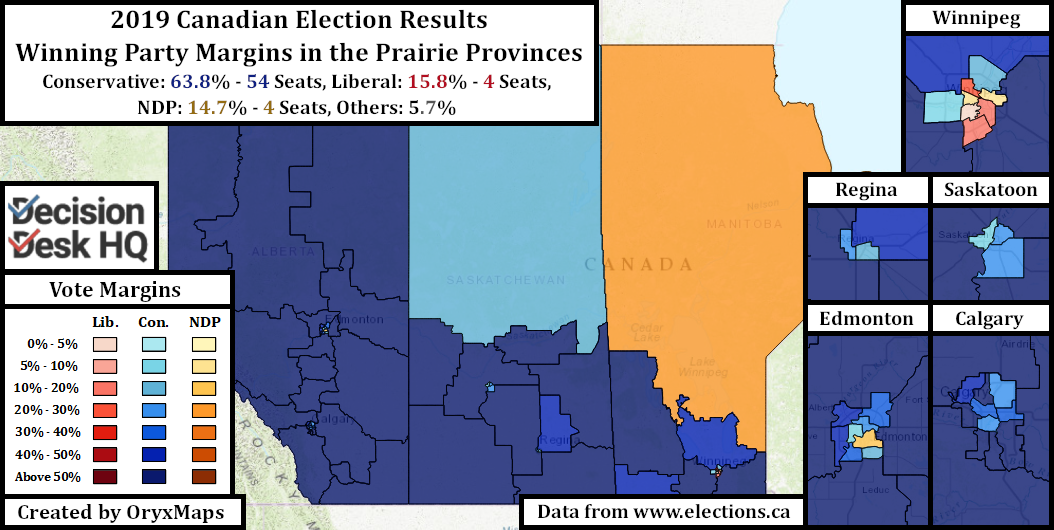
In the Prairies, the question is not about which party can win the few competitive seats – it is a question of what the Conservatives will lose. The Conservatives will lose votes in the Prairies compared to 2019. PPC polling numbers are inconsistent, but their votes in these provinces are coming straight from the Conservatives. United Conservative Alberta Premier Jason Kenney additionally gave the PPC a boost when he imposed vaccine passports on the province last Wednesday.
There are two types of seats in the prairies: urban areas and rural areas. If the PPC disaffection campaign spills over into urban areas like Saskatoon West and Edmonton Mill Woods then the Conservatives will lose multiple seats in their provincial strongholds. If the PPC surge is uneven, with candidates doing much better in the safe Conservative rural seats than in narrower urban areas, then the Conservatives may not lose any seats at all.
British Columbia + Territories
British Columbia is a true three-party province which makes polling the province’s federal electorate especially difficult. There are even two different narratives emerging about the province’s voters. Half the polls – including the high-quality provincial pollster Insights West – suggest a two-way race between the NDP and the Conservatives. The provincial subsample in other polls suggest a three-way race with all major parties around mid-30%. While the Greens were a significant presence in the province during the 2019 election, infighting shifted their former voters towards the NDP.
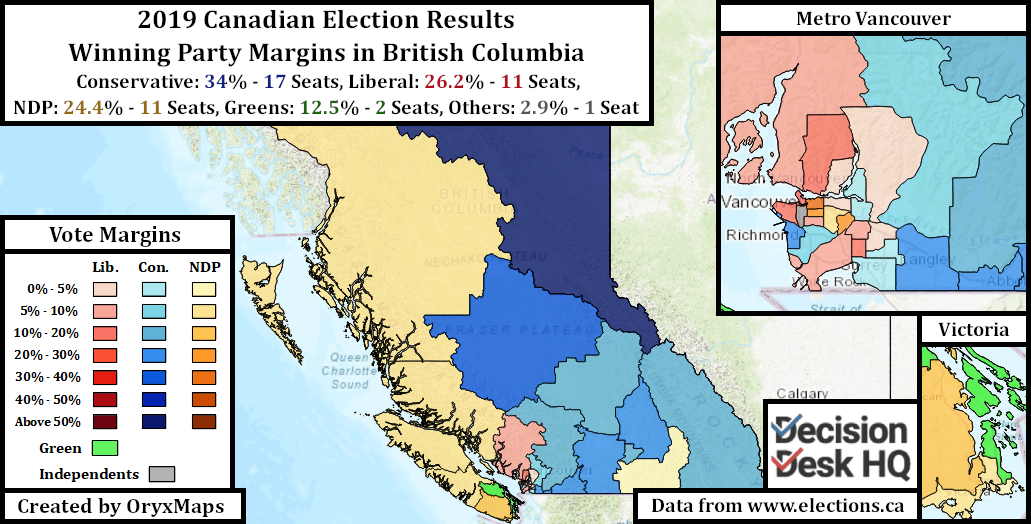
The first polling narrative would produce a result comparable to 2019, except with the Liberal and Green shares of the vote declining to the benefit of the NDP. The NDP has strong chances to gain seats from the Liberals which could leave the British Columbia Liberal delegation with fewer than five parliamentarians. The Conservatives also gain Liberal seats in this scenario through favorable vote splits in the Vancouver suburbs.
The second narrative would mean that the Liberals could gain up to five Conservative seats. Despite these gains, the party would still potentially lose seats to the NDP.
The Green party are guaranteed to hold onto their one safe seat in the country – former Party Leader Elizabeth May’s Saanich-Gulf Islands. Their second British Columbia seat, Nanaimo-Ladysmith, however could fall to the NDP or the Conservatives.
Additionally, the incumbent parliamentarians in the Yukon and Nunavut territories are not standing in this election. This opens up two more multi-party races, though these territories may take longer to count their votes than the smaller provincial constituencies.
Ben Lefkowitz (@OryxMaps) is a Contributor to Decision Desk HQ.